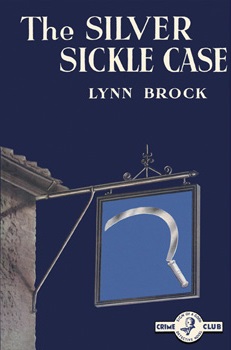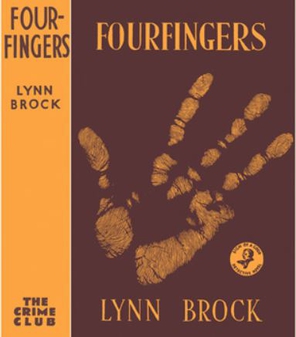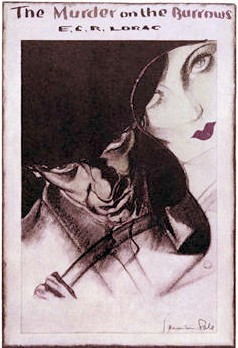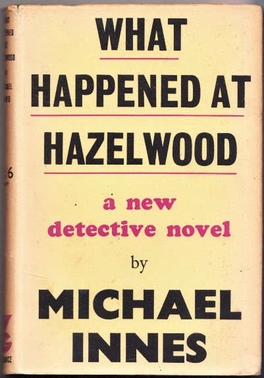
Wobble to Death is a 1970 historical detective novel by the British writer Peter Lovesey. It was the first of a series of eight novels featuring the Victorian era policeman Sergeant Daniel Cribb, a member of the Metropolitan Police. It was published in Britain by Macmillan and in America by Dodd, Mead & Co.. it received positive reviews from critics. The plot revolves around a walking marathon in 1879 in which several of the participants are murdered.

The Dagwort Coombe Murder is a 1929 mystery detective novel by the Irish-born writer Lynn Brock. It was the first stand-alone novel by Brock following the success of his Golden age detective Colonel Gore. It was published in the United States with the alternative title The Stoke Silver Case.

The Silver Sickle Case is a 1938 detective novel by the Irish-born writer Lynn Brock. Best known for his Colonel Gore series of mysteries, the novel introduced an alternative detective character Sergeant Venn of Scotland Yard assisted by Detective Constable Kither. It was followed by two sequels.

Fourfingers is a 1939 mystery detective novel by the Irish-born writer Lynn Brock. It was the second in his trilogy featuring the characters of Scotland Yard detective Sergeant Venn and Constable Kither. Writing in the Times Literary Supplement, reviewer Maurice Percy Ashley observed "Mr. Lynn Brock’s new book, Fourfingers, good though it is, is so closely written and so full of incident that it is a little heavy going for the reader in search of intellectual relaxation."

The Murder on the Burrows is a 1931 detective story by E.C.R. Lorac, the pen name of the British writer Edith Caroline Rivett. Her debut novel, it introduced the character of Chief Inspector MacDonald of Scotland Yard who went on to appear in a lengthy series of novels during the Golden Age of Detective Fiction. Although initially named James this is changed to Robert in later books. It takes place around Bideford Bay in North Devon where the author had spent several holidays.

Death of an Author is a 1935 detective novel by E.C.R. Lorac, the pen name of the British writer Edith Caroline Rivett. It is a rare standalone book by Lorac, not featuring Chief Inspector MacDonald of Scotland Yard who appeared in a lengthy series of novels during the Golden Age of Detective Fiction. It was her final novel published by Sampson Low before, she switched to the more prestigious Collins Crime Club with whom she remained for the rest of her career.

Death in White Pyjamas is a 1944 detective novel by the British writer John Bude. It is a stand-alone novel and does not feature his regular character Superintendent Meredith. Although written during the Second World War, no reference is made to the ongoing conflict. Originally published by Cassell, in 2020 it was reissued by the British Library Publishing in a single edition with another Bude novel Death Knows No Calendar, as part of a series of republished crime novels from the Golden Age of Detective Fiction.

The Lake District Murder is a 1935 detective novel by the British writer John Bude. It is the first in a series of novels featuring Chief Inspector Meredith, promoted at the end of case to Superintendent. Set in the Lake District of Northern England, it shows the influence of Freeman Wills Crofts's Inspector French novels by featuring a detective who methodically breaks down the alibis of his suspects. In 2014 it was reissued by the British Library Publishing as part of a group of republished crime novels from the Golden Age of Detective Fiction.

Nightmare is a 1932 thriller novel by the Irish-born writer Lynn Brock. It is an inverted detective story, and a stand alone work for an author best known for his series featuring the Golden Age detective Colonel Gore.

What Happened at Hazelwood is a 1946 detective novel by the British writer Michael Innes. It is a standalone novel from the author who was best known for his series featuring the Golden Age detective John Appleby. In this novel his role is fulfilled by Inspector Cadover who also appeared later in an Appleby novel A Private View. It takes the form of a country house mystery. Ralph Partridge writing in the New Statesman observed "Michael Innes may be a Professor of English in disguise but What Happened at Hazelwood would never win him a Chair of Detection. I suppose we should be grateful that it is not a surrealist thriller, and that Inspector Appleby is off duty."

Stop Press is a 1939 mystery detective novel by the British writer Michael Innes. It is the fourth in his series featuring John Appleby Detective Inspector of Scotland Yard. It was written during the Golden Age of Detective Fiction and was first published by Victor Gollancz and in America by Dodd Mead under the alternative title The Spider Strikes. A country house mystery, it is the only novel in the series in which Appleby's sister Patricia appears.

The Vultures Gather is a 1945 mystery detective novel by the British writer Anne Hocking. It was published in London by Geoffrey Bles. Written during the Golden Age of Detective Fiction, it is the seventh in her series featuring Chief Superintendent William Austen of Scotland Yard.

When the Case Was Opened is a 1952 mystery detective novel by the British writer John Bude. It is the ninth featuring his series character Chief Inspector Meredith of Scotland Yard, one of the numerous detectives featuring in the Golden Age of Detective Fiction.

Common Sense Is All You Need is a 1947 detective novel by the British author Alfred Walter Stewart, published under his pseudonym J.J. Connington. It was his last novel, published by Hodder and Stoughton the year of his death, and featured his regular character Sir Clinton Driffield. It was the seventeenth in a series of novels featuring Driffield, a Chief Constable of a rural English county, published during the Golden Age of Detective Fiction. Although published during the postwar era. it is set during the Second World War with German bombing raids taking place.

Murder in the Maze is a 1927 detective novel by the British author Alfred Walter Stewart, published under his pseudonym J.J. Connington. It was the first of seventeen novels featuring his best-known character the Golden Age Detective Sir Clinton Driffield, Chief Constable of an English county. It takes the form of a classic country house mystery. First published in Britain by Ernest Benn, it was released in the United States by Little, Brown and Company.

No Past Is Dead is a 1942 mystery detective novel by the British author Alfred Walter Stewart, published under his pseudonym J.J. Connington. It is the fifteenth in his series of novels featuring the Golden Age Detective Sir Clinton Driffield, the Chief Constable of a rural English county. It was published by Hodder and Stoughton in London and Little, Brown and Company in the United States.

The Detective Wore Silk Drawers is a 1971 historical detective novel by the British author Peter Lovesey. It was the second entry a series of eight novels featuring the Victorian era policeman Sergeant Daniel Cribb, a member of the Metropolitan Police. It is set against the backdrop of nineteenth century bare-knuckle boxing. In 1980 it was adapted into an episode of the same title for the ITV series Cribb.

Abracadaver is a 1972 historical mystery detective novel by the British author Peter Lovesey. It is the third in his series of novels featuring the Victorian era policeman Sergeant Daniel Cribb. Cribb a member of the Metropolitan Police investigates a crime that has taken place in the world of London's music halls. The title is a portmanteau of the words abracadabra, frequently used in magic tricks, and that of cadaver an alternative word for a corpse.

Murder at the Munition Works is a 1940 detective novel by the British husband and wife writing team G.D.H. Cole and Margaret Cole. One of the later entries into their series of Golden Age series featuring Superintendent Wilson of Scotland Yard, it was the first to be released following the outbreak of the Second World War. It was published by the Collins Crime Club and released by Macmillan in the United States.

Suicide Excepted is a 1939 detective novel by the British writer Cyril Hare. It was his third novel to feature Inspector Mallett of Scotland Yard, one of the numerous investigators of the Golden Age of Detective Fiction. Mallet takes a back seat for the middle of the novel and much of the detective work is done by three amateur detectives.




















